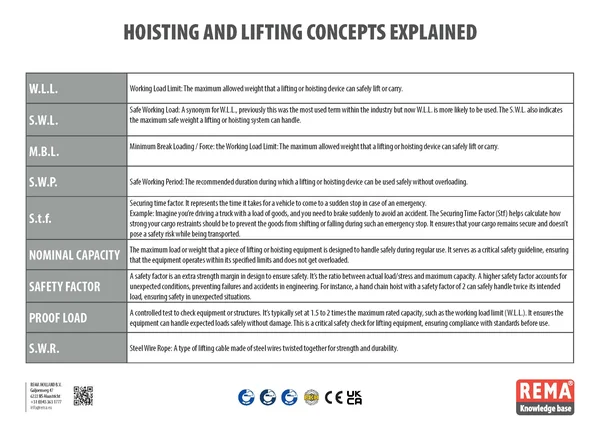If you have already experienced working with hoisting and lifting equipment, you're likely familiar with the frequent use of various terms and abbreviations. However, for those who may not be well-versed in these concepts, we have compiled a comprehensive list with explanations to help you understand their meanings.
W.L.L.
Working Load Limit: The maximum allowed weight that a lifting or hoisting device can safely lift or carry.
S.W.L.
Safe Working Load: A synonym for W.L.L., previously this was the most used term within the industry but now W.L.L. is more likely to be used. The S.W.L. also indicates the maximum safe weight a lifting or hoisting system can handle.
M.B.L. / M.B.F.
Minimum Breaking Load / Force: The load or force that must be reached before the lifting equipment risks breaking or undergoing a change that could cause the load to loosen.
This strength is measured during a test where the equipment is subjected to extreme stress.
The load is stated in kilograms (kg) or tons, and the force is expressed in kilonewtons (kN).
S.W.P.
Safe Working Period: The recommended duration during which a lifting or hoisting device can be used safely without overloading.
S.t.f.
Securing time factor. It represents the time it takes for a vehicle to come to a sudden stop in case of an emergency.
Example: Imagine you're driving a truck with a load of goods, and you need to brake suddenly to avoid an accident. The Securing Time Factor (Stf) helps calculate how strong your cargo restraints should be to prevent the goods from shifting or falling during such an emergency stop. It ensures that your cargo remains secure and doesn't pose a safety risk while being transported.
Nominal capacity
The maximum load or weight that a piece of lifting or hoisting equipment is designed to handle safely during regular use. It serves as a critical safety guideline, ensuring that the equipment operates within its specified limits and does not get overloaded.
Safety factor
A safety factor is an extra strength margin in design to ensure safety. It's ratio between actual load/stress and maximum capacity. A higher safety factor accounts for unexpected conditions, preventing failures and accidents in engineering.
Example: A hand chain hoist with a safety factor of 2 can handle double its intended load without risking failure. This extra capacity ensures safety in case of unexpected stresses or loads.
Proof load
Proof load is a controlled test load used to assess the strength, integrity, and performance of equipment or structures. It's often set at a percentage (usually 1.5 to 2 times) of the equipment's maximum rated capacity, like the working load limit (W.L.L.). The purpose of proof load testing is to confirm that the equipment can safely handle expected stresses and loads during regular use without deformation or failure. This testing is a crucial quality control and safety step for lifting and hoisting equipment, ensuring compliance with industry standards and safety regulations before it's used.

